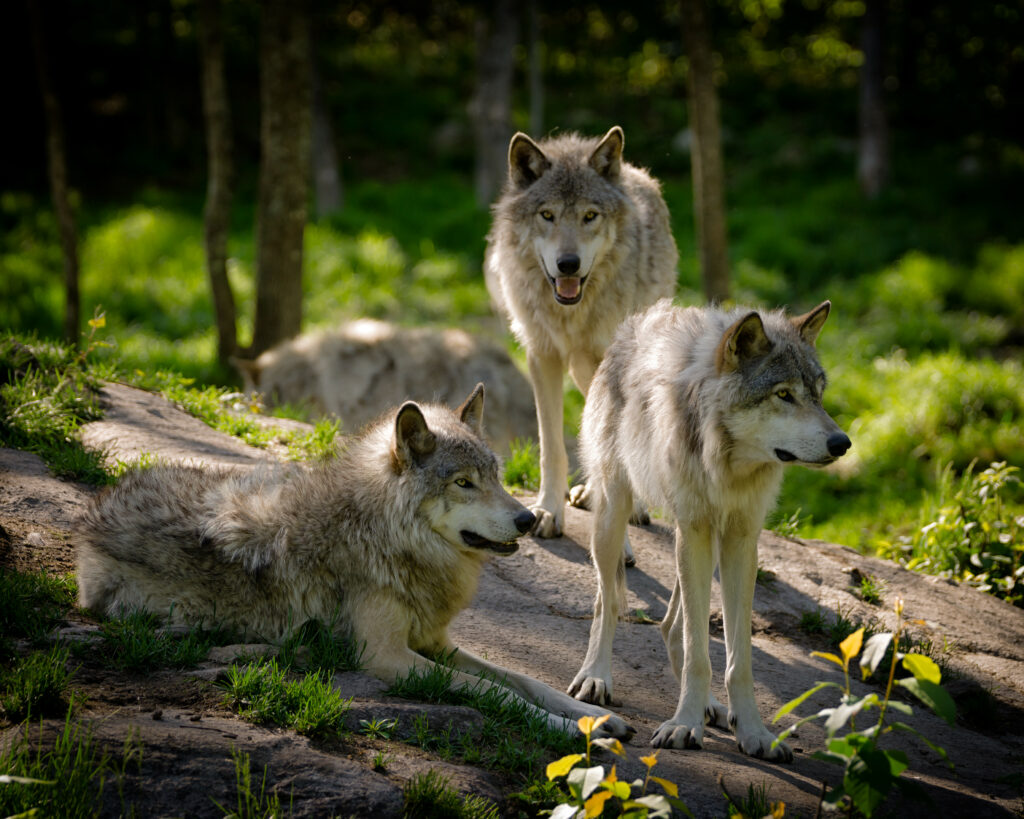
By T. Lee Brown
Tuesday, June 14, 2022 1:00 PM

Kids and adults gathered to get their books signed by bestselling author Rosanne Perry (nearest the door) and storyteller and author Susan Strauss (foreground). PHOTO BY T. LEE BROWN
“Wolf, eat me. End my miserable life,” begs Akiko, heroine of an ancient Japanese tale. But the wolf explains that his kind do not eat human beings. Instead, the wolf gives Akiko eyelashes she can wear to see the truth about people.
Akiko’s story was one of several relayed by celebrated storyteller Susan Strauss at the Wolf Welcome Committee’s event on Saturday at Paulina Springs Books. An audience of over 40 attendees listened intently to Strauss and author Rosanne Parry, who wrote the New York Times bestseller “A Wolf Called Wander” and other popular books for middle readers.
Strauss talked of her experiences watching wolves hunt together in Yellowstone National Park.
“There was kind of a telepathy” between the wolves, she said.
Indigenous people of Europe admired wolves, she suggested, told stories about human children raised by she-wolves, and gave their children wolf-oriented names to suggest nobility, stamina, and strength.
Strauss told the Norse myth of Sól and Máni, the goddess and god of the sun and moon. These deities drive their chariots across the sky because they are chased by Sköll and Hati, the wolves of Gullveig. Without them, there would be no movement, no day and night.
Similarly, when wolves were eliminated from the wilds of North American places including Yellowstone, movement among other animals slowed. Habitats changed, and not for the better.
Once wolves were reintroduced, “Things began to move,” said Strauss.
Parry spoke of wolves and orcas — the subject of her book “A Whale of the Wild” — as “apex predators. They are incredibly strong and big. They could easily kill human beings, but they don’t.”
She noted similarities between orca pods, wolf packs, and humans.
Living in Germany, traveling in Europe, and studying fairytales, Parry noticed that storybook bears are “pretty benign,” but wolves are portrayed as mean, dangerous, and scary. In reality, “bears are dangerous to people in a way that wolves have never been.”
She observed that the Big Bad Wolf types in the Grimm fairytales eat humans and try to get into people’s houses. Whereas in real life, The Boy Who Cried Wolf wouldn’t need to round up his whole village for help. “One boy with a slingshot can drive off a wolf,” she said.
Parry described her intriguing theory as to why the Big Bad Wolf image permeated European stories.
The wolf was a symbol of Rome, a city founded in 753 BCE by Romulus, who was said to have been raised by a she-wolf. Roman society ran on slavery. Romans made forays into areas including Germany, trafficking people into slavery.
In Parry’s theory, fairy stories like “Little Red Riding Hood” and “The Three Little Pigs” were cautionary tales, teaching kids in Germany and the Slavic countries to avoid strangers (who might be slave-takers) and build strong houses (to hide in).
Now that we have radio collars on the re-wilded wolves of North America, she said, we can see that wolves go out of their way to avoid human beings. In reality, she said, there are zero recorded incidents of wolves killing humans in North America. The scary “wolves” of the old stories were actually Romans.
The Boy Who Cried Wolf required his village not to chase off a wolf, but to chase off a different kind of predator. “The moral of the story is to keep good communication and relationship with your village,” she concluded.
After the talk, people stood in line to have their books signed. “I love animals, and I love animal books,” said Quinn Anderson, a sixth grader at Sisters Middle School.
Black Butte School kindergarten student Zephyr Sharp asked Parry a question about “A Wolf Called Wander” (spoiler alert): Warm is the close brother of the main character. Did he have to die?
“Warm did what most wild animals do who are injured,” responded Parry, “He found a place to hide and held very still for a couple of days so that his bones could knit back together.
“I think it’s possible that Warm could’ve died, but if he found a safe place to hide, it is also possible that he could survive,” Parry said. “I think those brothers love each other so much, Wander would’ve never have left if he thought his brother was still there… But I have lots of hope for Warm.”
Said Zephyr’s mom, Jennie Sharp, “It was very affecting, but it was also a very good lesson—that we love each other and we take care of each other when we can.”
